ISSN ONLINE(2319-8753)PRINT(2347-6710)
ISSN ONLINE(2319-8753)PRINT(2347-6710)
Dr. B.S. Deshmukh1, S. N. Pimpalkar2, R. M. Rakhunde3 and Dr. V. A. Joshi4
|
| Related article at Pubmed, Scholar Google |
Visit for more related articles at International Journal of Innovative Research in Science, Engineering and Technology
The polysaccharides and proteins of various seeds have bioflocculant properties. The performance of naturally occurring Strychnos potatorum was evaluated against the chemical coagulant alum. The study involved extensive jar test experiments using Strychnos potatorum suspension and alum solution either independently or in combination with spiked turbid water prepared in the laboratory. It was observed that reduction in turbidity level depend on the raw water turbidity. Strychnos potatorum was found effective when used in low dosages 0.25 to 3.5 mg/L. It acts as good coagulant and coagulant aid at higher turbidity 1000-3000 NTU. The prepared solution of Strychnos potatorum was kept for 4 days in refrigerator. It was used for removal of turbidity at nearly same raw water turbidity with identical dose to evaluate the effect of aging. The removal efficiency of Strychnos potatorum solution was observed better on second day as compare to first, second and third day.
Keywords |
| Coagulant aid, jar test, Nirmali seed, natural coagulant, aging studies |
I. INTRODUCTION |
| Turbidity removal is one of the important steps in water treatment process and generally is achieved by using coagulation process. Turbidity is caused by the presence of suspended particulate matter or impurities that interfere with the clarity of the water such as clays, silts, finely divided inorganic and organic particles, soluble substances, plankton and other microscopic organisms in water [1]. Turbidity can also provide food for pathogenic microorganisms and particles of turbidity provide shelter for microorganisms by reducing their exposure to attack by disinfectants [2], [3]. Many coagulants have been widely used in conventional water-treatment processes depending on their chemical characteristics [4], [5], [6]. The process of coagulation to clarify water using coagulant or coagulant aid is an ancient practice. Many developing countries can hardly afford the high costs of imported chemicals for turbid water and wastewater treatment. In this context, environmental friendly coagulant presents a viable alternative for the treatment of wastewater [7] and turbid water [8]. |
| The natural Strychnos potatorum (Nirmali seed) is widely used as coagulants to clarify turbid waters. In recent years natural and synthetically prepared organic Strychnos potatorums have been increasingly used in the coagulation of suspended matter in water and wastewater treatment. The natural coagulants extracted from plants or animals can be workable alternatives to synthetic Strychnos potatorums as they are biodegradable, safe to human health and have a wider effective dosage range for flocculation of various colloidal suspensions [9], [10], [11]. One source of a natural Strychnos potatorum of local origin is the seed of Strychnos potatorum Linn, commonly known as clearing nut or Nirmali seed [12]. Strychnos potatorum is one of the group of trees which produce the complex and related alkaloids, strychnine and brucine. It grows profusely in various parts of India and South-East Asia. The chemical composition of the coagulant in Strychnos potatorum has been identified as a polysaccharide consisting of a 1:7 mixture of galactomannan and galactan. These findings suggest that the seed extracts may function as a particulate, colloidal and soluble polymeric coagulant as well as a coagulant aid [13]. The use of Strychnos potatorum seed for removal of turbidity from water was mentioned in Sushruta Samhita [14]. Sanskrit writings from India reported that the seeds of the Nirmali tree were used to clarify turbid surface water over 4000 years ago [11], [15]. The seeds have shown a high coagulation activity for high-turbidity water and vice-versa [16]. The settling ability of the particulate matter depends on the density of the material and the size of particles. The size of colloidal particles are in the range of a few nanometers up to some hundred micrometers, usual colloidal particles in surface waters have sites ranging from 0.001 up to 10 microns .The time to settle down these particles range from half an hour up to 63 hours [17]. The aim of the present study is to establish the usefulness of Strychnos potatorum and evaluate the performance of it in turbid water and compare its performance with alum. |
II. MATERIALS AND METHODS |
| The turbidity of the natural water was made up of complex nature of particles consisting principally of various colloidal clays and to a lesser extent live and decaying algae and their decomposition products, bacterial cells, decaying organic matter. The preparation of stable clay suspension of colloidal dimensions with known turbidity was prepared in tap water. For this purpose black cotton soil collected from NEERI premises was air-dried and crushed manually using mortar and passed through100 mm sieve. This soil was added to 5L of tap water and mixed thoroughly and allowed to swell in water for about 24 hrs. The suspension was blended in high speed varying blends for 5 to 10 minutes. The blended portion was further diluted with water to obtain turbid suspension. This suspension was again allowed to settle overnight. The supernatant was decanted without disturbing the sediment and used as a stock turbidity suspension. The suspension of desired turbidity was then prepared by diluting the stock suspension by adding tap water. |
| There is no simple formula for determining coagulant doses for best clarification of turbid water. Laboratory tests are valuable indicators of the probable doses required to bring down the turbidity to desired level. However, results at the pilot plant study are the best guides. The Jar test is the simplest, most practical and accepted means of determining the optimum dose of a coagulant required for turbidity removal [18], [19]. Jar test experiments were conducted by taking adequate (1000 ml) quantity of raw water in glass beakers for flocculation with Jar Tester (Phipps and Bird Stirrer Model: 7790 - 402) instrument. After addition of Strychnos potatorum or alum, rapid agitation was maintained at 100 + 10 rpm for one minute followed by slow agitation at 20 + 5 rpm for 20 min. The settled water turbidity in the beaker was measured after 20 minutes of settling time [20] by HACH (Model - 2100 A) turbidity meter. |
III. RESULTS AND DISCUSSIONS |
| A. Aging effect |
| The aging studies on suspension of Strychnos potatorum (S. potatorum) were performed by using the same suspension for 4 days for the turbidity removal at raw water turbidity (RWT) between 175 and 190 NTU (Nephlometric Turbidity Unit) (Fig. 1). The removal efficiency of Strychnos potatorum suspension was observed better on second day and then deteriorates on third and fourth day. The turbidity removal capacity of suspension increased from 61.9% to 70.3% on second day and then reduced to 49.2% and 46.6% on third and fourth day. |
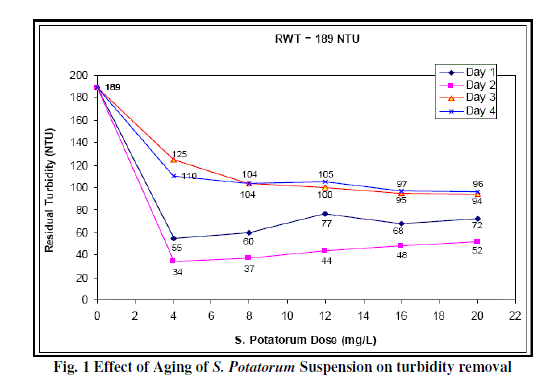 |
| B. Comparative study with alum as coagulant |
| The study involved extensive jar test experiments using Strychnos potatorum suspension and alum solution either independently or in combination with different concentration for spiked turbidity prepared under laboratory conditions. The data collected on comparative performance of Strychnos potatorum vis-a-vis alum for different turbidity as coagulant and coagulant aid is presented in Fig. 2 to 8. |
| For raw water turbidity around 125 NTU, the dose of alum and Strychnos potatorum were studied at 1-30 mg/L and 0.25-3.5 mg/L respectively (Fig. 2). When alum dose of 30 mg/L was added, the residual turbidity observed was 6 NTU with 98.9% reduction. The residual turbidity 52 NTU was achieved with optimum dose 3 mg/L of Strychnos potatorum with reduction of 58.4%. The increase in dose of Strychnos potatorum did not reduce the residual turbidity but increased from 57 and 62 NTU with Strychnos potatorum dose of 3.5 and 5 mg/L respectively. |
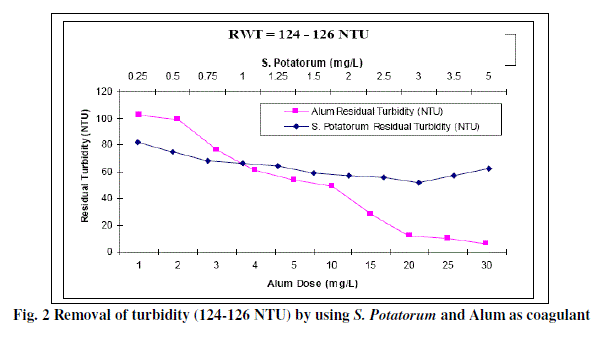 |
| The alum (2 – 25 mg/L) and Strychnos potatorum (0.25 – 3.5 mg/L & 5 – 25mg/L) doses were applied to obtain the turbidity of settled water below 10 NTU from a raw water turbidity around 206-216 NTU (Fig. 3). The optimum dose of alum to reach the turbidity 9 NTU was 25 mg/L with 95.73% reduction. The minimum residual turbidity obtained was 40 NTU with 3.5 mg/L dose of Strychnos potatorum with 81.04% reduction. The further increase in dose of Strychnos potatorum from 5, 10, 15, 20 and 25 mg/L increased the residual turbidity to 42, 50, 57, 79 and 102 NTU respectively. |
| The effectivity and comparative performance of Strychnos potatorum with alum tested at 1000-1060 NTU (Fig. 4) showed that the minimum turbidity 61 NTU and 3 NTU was obtained with optimum dose 4.0 mg/L with 94.08% reduction and 90 mg/L with 99.70% reduction of Strychnos potatorum and alum respectively. The increase dose of Strychnos potatorum more than 4.0 mg/L increased the residual turbidity. The boosted does 5-12 mg/L increased the turbidity from 61 NTU to 76 NTU. |
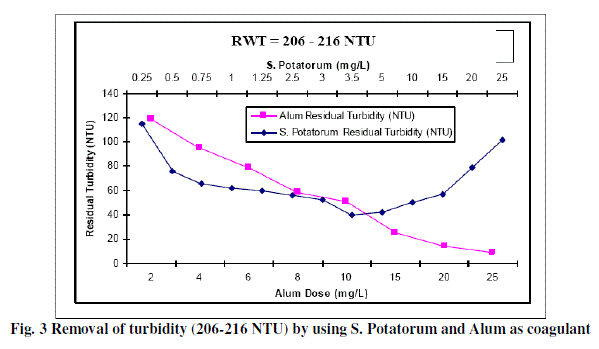 |
| For raw water turbidity around 2200 – 2260 NTU, the dose of alum and Strychnos potatorum were studied at 20-220 mg/L and 0.25-30 mg/L respectively (Fig. 5). When alum dose of 220 mg/L was added, the residual turbidity was 2 NTU with 99.91% reduction. The residual turbidity 22 NTU was achieved with optimum dose 15 mg/L of Strychnos potatorum with 99.01% reduction. The increased dose of Strychnos potatorum from 15 mg/L to 30 mg/L did not show significant decrease in turbidity on the other hand increased doses (25mg/L and 30 mg/L) increased residual turbidity upto 28 NTU. |
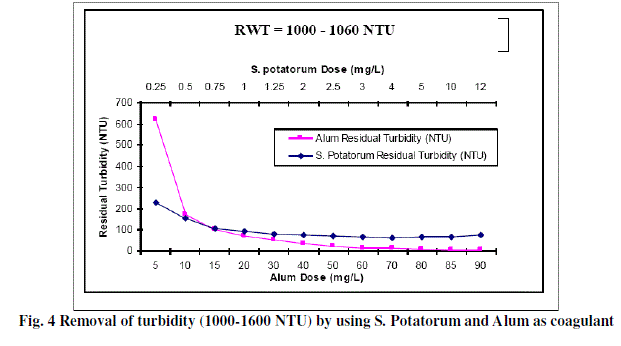 |
| The highest raw water simulated turbidity was 3400 NTU (Fig. 6). The alum dose needed to reduce the turbidity from 3400 NTU to 4 NTU was 220 mg/L. The minimum turbidity was obtained 56 NTU with Strychnos potatorum dose of 6.0 mg/L. The increase in dose of polyelectrolyte as 8.0, 12.0, 16 and 20 mg/L shows increase in residual turbidity of 58, 59, 63 and 70 NTU respectively. The turbidity was increased with additional doses of Strychnos potatorum. |
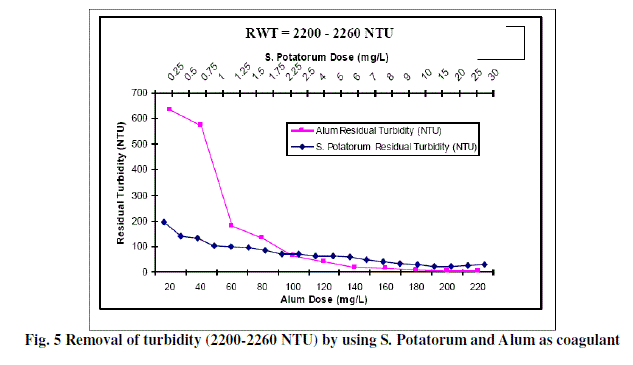 |
| C. Comparative study with alum as coagulant aid |
| While using Strychnos potatorum as coagulant aid, the addition sequence of Strychnos potatorum before or after the addition of alum was decided by carrying out number of Jar test experiments. The addition of Strychnos potatorum before the addition of alum found more effective for the raw water turbidity in the range 1000 – 1050 NTU, the doses of Strychnos potatorum as coagulant aid were 0.5 to 3 mg/L with alum doses ranging between 10 and 30 mg/L. With 3.0 mg/L of Strychnos potatorum as coagulant aid with alum 10.0 mg/L showed settled water turbidity of 63 NTU which reduced to 42 NTU when 2.0 mg/L of Strychnos potatorum was added with 20 mg/L alum. The turbidity reduction upto 30 NTU was achieved with 3 mg/L of Strychnos potatorum and 30 mg/L alum (Fig. 7). The Strychnos potatorum with varying doses of 0.5-2 mg/L as coagulant aid were studied at turbidity in the range 2200 to 2189 NTU (Fig. 8) along with alum doses of 10 to 170 mg/L. The residual turbidity < 5.0 NTU was obtained, when alum doses 150 , 160 and 170 mg/L were used with Strychnos potatorum dose 0.5, 1.25 and 2.0 mg/L respectively. The alum dose alone required to obtained turbidity < 5.00 NTU was 220 mg/L. |
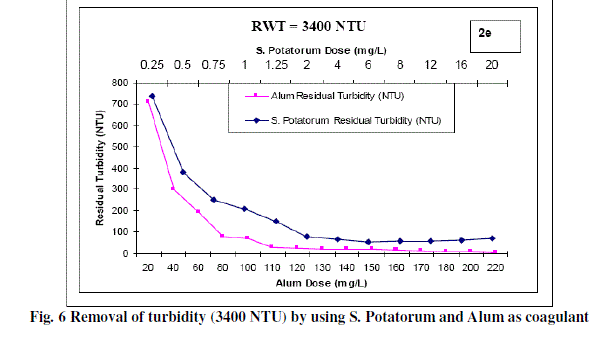 |
IV. CONCLUSIONS |
| The Strychnos potatorum seed can be used as coagulant and coagulant aid in water treatment with limited efficiency, to avoiding the health effect from residual aluminium. It is not an effective coagulant for low turbidity as compared to alum. The turbidity removal efficiency of Strychnos potatorum suspension was observed better on second day and then deteriorates on third and fourth day coagulation efficiency of Strychnos potatorum stock solution on water samples depended on the initial turbidity of the water sample, at optimum dosage, the percentage of turbidity removal was found to increase with increasing initial turbidity. |
ACKNOWLEDGEMENT |
| The authors would like to acknowledge the Girijan Co-operative Corporation Limited (GCCL), Vishakhapattnam, India, for financial support and provided the Strychnos potatoram seeds throughout this research studies. Thanks to Dr. S.R. Wate, Director, NEERI, for completion of this work. |
References |
|